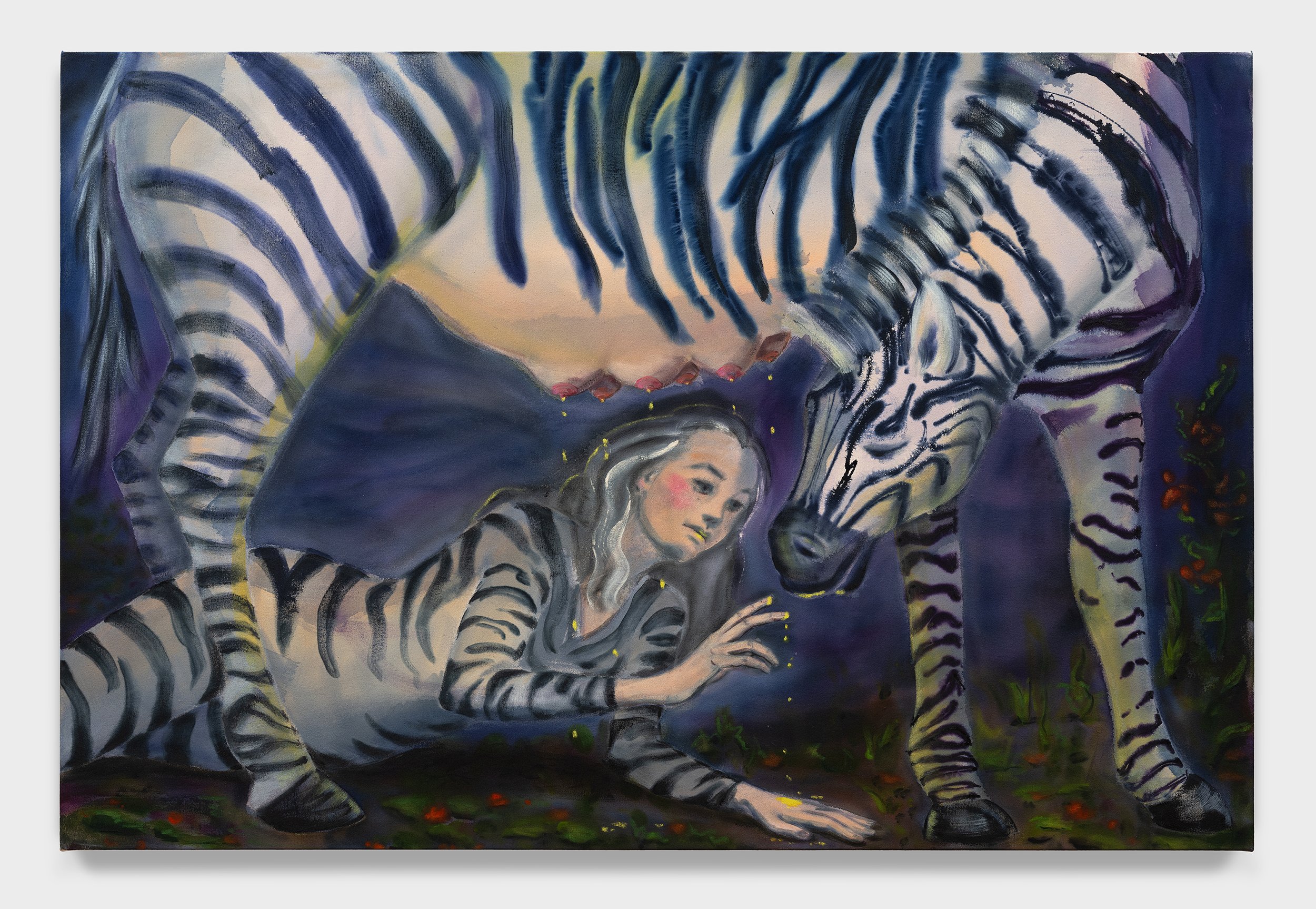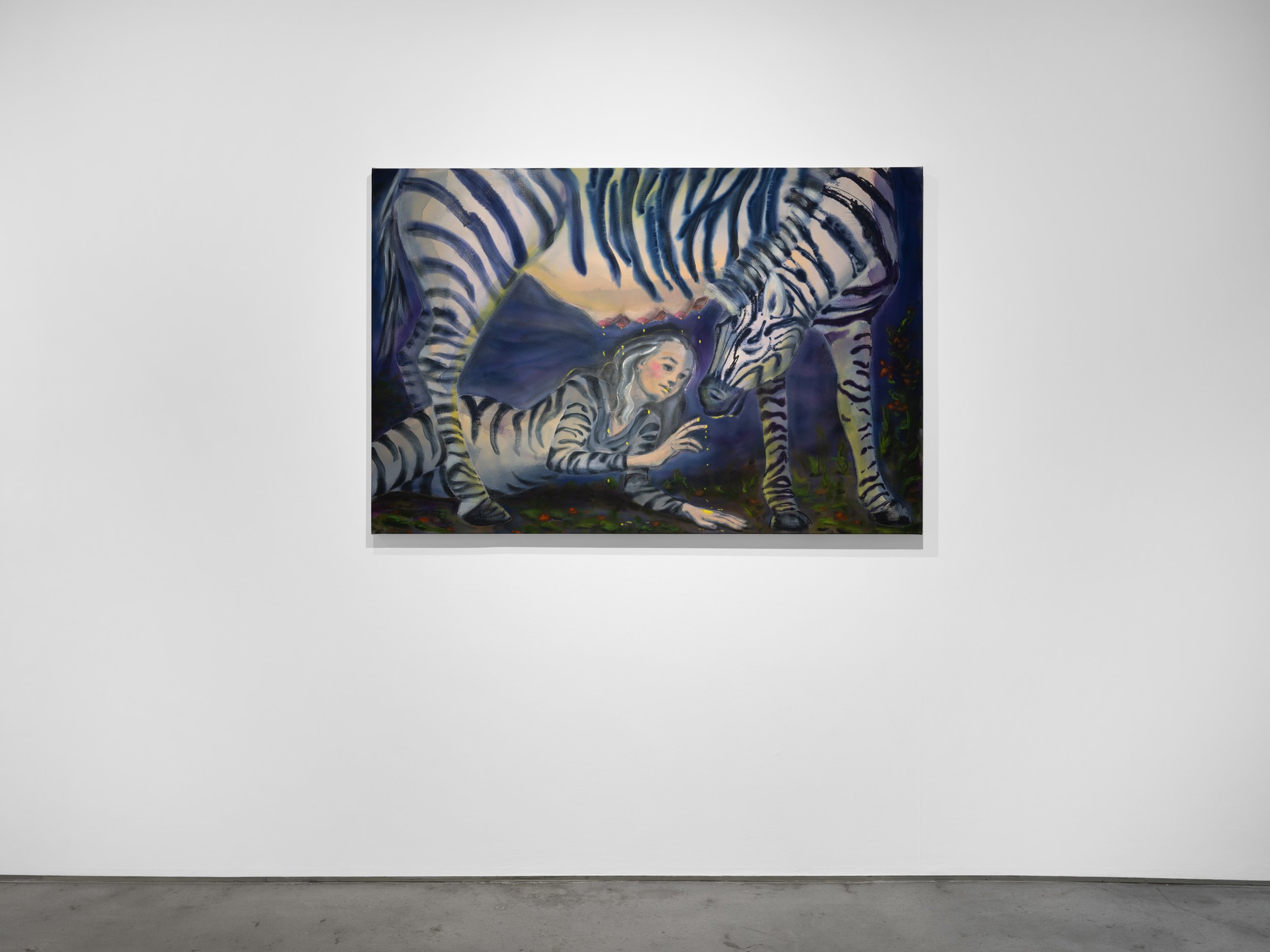My Pet Ram is pleased to present Thirst Trap, the first New York solo exhibition for Brooklyn-based artist Sarah Alice Moran.
Moran specializes in an atmospheric dreaminess situated somewhere between the allegorically sophisticated paintings of the Florentine Mannerists and a macabre version of Saturday morning cartoons. Her paintings have always been personal: the female figures in them tend to resemble her, and their sweetness often belies an achingly melancholic subtext. The speed and confidence with which she works would not seem to lend itself to quiet moments like the dazed expression on the face of a milk-drunk hare, or the twinkle of a small star conveyed in mottled shadows under a figure’s chin. But look closely, and Moran’s paintings are spilling over with care.
Moran works directly on unprimed stretched canvases that she lays flat on the ground. Creating mixtures in different viscosities of acrylic paint, matte medium and water, she then paints, pours, and spreads the pigment in multiple layers of semi-transparent paint, sometimes drawing into them with jets of thinned-out paint directly from the tip of a squeeze bottle. Later, she adds opaque, textural strokes with a dry brush.
The subject matter is a provocation, isn’t it? Were we prepared to be so drawn to depictions of woodland creatures nursing at a human (a monstrous woman?) with multiple nipples, an adult woman suckling from a tiger, a zebra, a snake with seemingly human anatomy? Improbably, given the broader cultural narrative around breasts, Moran has imbued these images with tenderness and mysticism. Speaking of this body of work, she has said, “There can be a mystical piercing of veils between different worlds that can be accessed through this feminine power. Within these scenes there’s something that feels forbidden and mythic, like an ancient spell, but also natural and beautiful.”
Still, they are unsettling. Julia Kristeva famously linked the maternal body and the experience of abjection in her 1982 essay Powers of Horror. For Kristeva, milk belongs to the abject because of its other-bodiedness, or inter-bodiedness: when the boundaries of what is body and not-body become mutable, a state of abjection collects, she imagines, miasmically around the action of leaking and oozing—something that the maternal body does with great skill and frequency. “Food,” she writes, “becomes abject only if it is a border between two distinct entities or territories: a boundary between nature and culture, between the human and the non-human.” If we are unsettled at the sight of a breastfeeding woman, perhaps it is because she reminds us that we are animals.
For her part, Moran is as preoccupied with composition as she is with allegory. She admires Édouard Vuillard’s 1893 Interior, Mother and Sister of the Artist, the way one figure appears to bend under the weight of the outside edge of the canvas; it inspired her framing of human subjects inside windows created by animals’ legs and bellies. Working on Waxing Gibbous, she studied Caravaggio’s Judith Beheading Holofernes, aiming to capture a similar attitude of grim determination in her subject.
It’s the expression on the face of the woman in Waxing Gibbous that signals that the subject is conscious of the viewer’s gaze. Ushered as she is into a visual culture in which the female nude is for easy consumption and hardly ever for confronting the primal conditions of maternal care, the woman seems to grasp what we feel as we look at her. Half-enchanting, half-abject, her presence here in public is a kind of trap: a reminder that we were all born thirsty.
Thirst Trap will be on view beginning Friday, February 23 through Sunday, March 24, 2024. The gallery is located at 48 Hester Street in the Lower East Side. Gallery hours are Thursday-Sunday from 12-6pm and by appointment. For more information about this exhibition, please email info@mypetram.com.
Sarah Alice Moran (b. 1982, New York, NY) received a BA from Bowdoin College, Brunswick, Maine and an MFA from the Massachusetts College of Art and Design, Boston. Moran’s work was the subject of a solo exhibition at Smoke the Moon, Santa Fe in 2022. Recent group exhibitions include September Gallery, Kinderhook, NY; Shelter Gallery, NYC; Ladies’ Room, Los Angeles; 1969 Gallery, NYC; Pratt Institute, Brooklyn. Moran has participated in residencies at Anderson Ranch Art Center, CO; The Wassaic Project, NY; Can Serrat, Spain.
Sarah Alice Moran
Thirst Trap (Zebra), 2024
Acrylic on canvas
40 x 60 inches
Sarah Alice Moran
Sleeping Fawn, 2023
Acrylic on canvas
16 x 19 inches
Sarah Alice Moran
Alpha Serpentis, 2023
Acrylic on canvas
40 x 32 inches
Sarah Alice Moran
Dusk To Dawn, 2024
Acrylic on canvas
27 x 30 inches
Sarah Alice Moran
Waxing Gibbous, 2023
Acrylic on canvas
60 x 40 inches
Sarah Alice Moran
Sky, 2024
Acrylic on canvas
11 x 14 inches
Sarah Alice Moran
Ghost, 2024
Acrylic on canvas
32 x 40 inches
Sarah Alice Moran
Star Gazer, 2023
Acrylic on canvas
40 x 32 inches
-In The Nook-
Sophia Raush
Untitled, 2021
Pencil on paper
8.5 x 11 inches
Sophia Raush
Untitled, 2021
Pencil on paper
8.5 x 11 inches
Sophia Rauch is a 2D artist focused on abstraction and artistic myth. She was born in Berkeley CA in 1984, and is based in Brooklyn, New York. She has shown internationally and published her artist book Scans at Home with FLTFL. Rauch received her BFA from the School of Visual Arts in 2008, and her MFA from the School of the Art Institute of Chicago in 2012.
Rauch collects and transforms modern detritus, gravitating towards delicate packaging and fabrics. She began collecting paper grocery bags early in the pandemic, drawn to their crisp shape and natural mimicry of the rectangular painting space. She paints the bags in her acidic palette, and stages them as wall and tabletop sculptures. Over time these works have become still life drawings, memorializing the ephemeral object and multiplying it through repeated representations. After circling abstraction for many years, Rauch landed in this dubiously representational model to illustrate her formal curiosity and phenomenological imperative. She explores the aesthetics of labor and the complexities of seeking beauty within our contemporary culture.



















